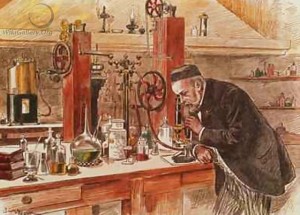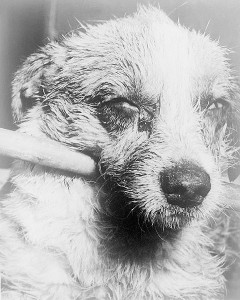
"He was universally advised to take the boy at once to Paris and place him under the advisement of Pasteur."
Legendary French chemist and bacteriologist Louis Pasteur treated his first human patient for rabies, or “hydrophobia,” in 1885 after testing his vaccine on fewer than ten dogs. It was a bold move that proved successful in defeating what had been a killer virus. But his treatment hadn’t yet become widespread in the U.S. by the following year when four people were bitten by a rabid dog in Chicago. The only answer was to send them to France and Dr. Pasteur for treatment. The Brooklyn Daily Eagle reported the story on April 28, 1886. An excerpt:
“A big white dog, mad with rabies, appeared on Fulton street, in Pullman, yesterday afternoon. He was heated, but his tongue did not protrude. His jaws were covered with thick foam. The dog went along the street quietly until opposite the house of Al Klingel, a railroad switchman. There the brute turned, dashed across the street, seized Johnnie Klingel, aged 8, by the cheek. The animal then started down the street and meeting a little boy named Connors bit him severely in the hand. Then the dog retraced his way on the street, attacking everything that confronted him, but never turning aside. Meeting another boy, he seized him by the seat of the trousers and nearly tore the garment from the lad, but his teeth did not touch the flesh. A moment later an adventurous dog tried to make the acquaintance of his mad brother. A short fight ensued and the mad dog proceeded. Within a block he attacked another dog and sent the unfortunate away howling. By this time the street was aroused and Police Officer Kane and Cassenbrot pursued the dog to Kensington, where he ran into a saloon.
 The officers took refuge on a card table and tried to shoot the dog but failed. The dog escaped from the saloon, followed by the officers. In the street a bold boy attacked the dog with a ball bat. He gave the animal one blow and then climbed the fence. Here the policeman overtook the brute, and Officer Kane fired. The ball struck in back of the dog’s head and he fell. Kane approached him and fired another ball into the dog’s body, thinking to make the killing sure, but the animal struggled up and attempted to escape. Again Kane fired, the shot breaking the dog’s leg. He fell, but once got to his feet and rushed upon Officer Cassenbrot. With a savage crunch he set his teeth in the man’s wrist, lacerating it terribly. Yelling like mad the officer shook him off, and as the dog gathered himself for another attack. Officer Kane fired a bullet into the brute’s mouth by killing him. A search was made for the two dogs bitten by the mad one. They were found and killed. Physicians were at once called to attend the two boys who were bitten. Their wounds were burned with caustic, but the physicians gave no hope of preventing hydrophobia. It was soon learned that the mad dog had been in Wildwood last Saturday. On that day he bit Percy Perkins, son of the Superintendent of the Pullman Iron and Steel Works. The boy is 12 years old. He was bitten on the end of the finger, and yesterday his hand and arm were much swollen and he was suffering great pain.
The officers took refuge on a card table and tried to shoot the dog but failed. The dog escaped from the saloon, followed by the officers. In the street a bold boy attacked the dog with a ball bat. He gave the animal one blow and then climbed the fence. Here the policeman overtook the brute, and Officer Kane fired. The ball struck in back of the dog’s head and he fell. Kane approached him and fired another ball into the dog’s body, thinking to make the killing sure, but the animal struggled up and attempted to escape. Again Kane fired, the shot breaking the dog’s leg. He fell, but once got to his feet and rushed upon Officer Cassenbrot. With a savage crunch he set his teeth in the man’s wrist, lacerating it terribly. Yelling like mad the officer shook him off, and as the dog gathered himself for another attack. Officer Kane fired a bullet into the brute’s mouth by killing him. A search was made for the two dogs bitten by the mad one. They were found and killed. Physicians were at once called to attend the two boys who were bitten. Their wounds were burned with caustic, but the physicians gave no hope of preventing hydrophobia. It was soon learned that the mad dog had been in Wildwood last Saturday. On that day he bit Percy Perkins, son of the Superintendent of the Pullman Iron and Steel Works. The boy is 12 years old. He was bitten on the end of the finger, and yesterday his hand and arm were much swollen and he was suffering great pain.
Mr. Perkins consulted with several physicians yesterday and he was universally advised to take the boy at once to Paris and place him under the advisement of Pasteur. Acting under this advice he made arrangements to start the boy with his mother for Paris to-day. The sympathy expressed in the village last night resulted in the circulation of a subscription paper to raise sufficient funds to send all the bitten children to Paris. A considerable amount of money was subscribed. Mr. Perkins had decided not to send his boy away until this evening, and it is probable the three wounded children will go together. Officer Cassenbrot’s wound is the most severe of any. What treatment he will receive has not been determined upon.”
